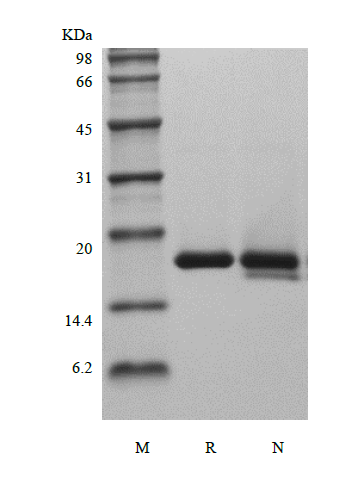- Synonyms
- IL-1RN, IRAP, IL1 Inhibitor
- Source
- Escherichia coli.
- Molecular Weight
- Approximately 17.4 kDa, a single non-glycosylated polypeptide chain containing 152 amino acids.
- AA Sequence
- HPAGKRPCKM QAFRIWDTNQ KTFYLRNNQL IAGYLQGPNT KLEEKIDMVP IDFRNVFLGI HGGKLCLSCV KSGDDTKLQL EEVNITDLNK NKEEDKRFTF IRSETGPTTS FESLACPGWF LCTTLEADHP VSLTNTPKEP CTVTKFYFQE DQ
- Purity
- > 96 % by SDS-PAGE and HPLC analyses.
- Biological Activity
- Fully biologically active when compared to standard. The ED50 as determined by inhibiting IL-1α-dependent proliferation of murine D10S cells is less than 150 ng/ml, corresponding to a specific activity of > 6.7 × 103 IU/mg in the presence of 50 pg/ml rRtIL-1α.
- Physical Appearance
- Sterile Filtered White lyophilized (freeze-dried) powder.
- Formulation
- Lyophilized from a 0.2 µm filtered concentrated solution in PBS, pH 7.4.
- Endotoxin
- Less than 1 EU/µg of rRtIL-1RA as determined by LAL method.
- Reconstitution
- We recommend that this vial be briefly centrifuged prior to opening to bring the contents to the bottom. Reconstitute in sterile distilled water or aqueous buffer containing 0.1 % BSA to a concentration of 0.1-1.0 mg/mL. Stock solutions should be apportioned into working aliquots and stored at ≤ -20 °C. Further dilutions should be made in appropriate buffered solutions.
- Stability & Storage
- Use a manual defrost freezer and avoid repeated freeze-thaw cycles.
- 12 months from date of receipt, -20 to -70 °C as supplied.
- 1 month, 2 to 8 °C under sterile conditions after reconstitution.
- 3 months, -20 to -70 °C under sterile conditions after reconstitution.
- Usage
- This material is offered by Shanghai PrimeGene Bio-Tech for research, laboratory or further evaluation purposes. NOT FOR HUMAN USE.
- SDS-PAGE

- Reference
- 1. Dinarello CA. 1994. FASEB J. 8:1314-25.
2. Patterson D, Jones C, Hart I, et al. 1993. Genomics. 15:173-6.
3. Steinkasserer A, Spurr NK, Cox S, et al. 1992. Genomics. 13:654-7.
4. Perrier S, Darakhshan F, Hajduch E. 2006. FEBS Lett. 580:6289-94.
5. Gabay C, Porter B, Fantuzzi G, et al. 1997. J Immunol. 159:5905-13.
- Background
- IL-1RA was initially called the IL-1 inhibitor which is encoded by the IL1RN gene and it is a member of the interleukin 1 cytokine family. IL-1RA is secreted by various types of cells including immune cells, epithelial cells, and adipocytes. IL-RA has functions of inhibiting the activity of interleukin-1 by binding to receptor IL1R1 and preventing its association with the coreceptor IL1RAP for signaling. IL-1RA is also used in the treatment of rheumatoid arthritis, an autoimmune disease in which IL-1 plays a key role. The rat IL-1RA is a single non-glycosylated polypeptide chain containing 152 amino acids and it has been shown to block the inflammatory responses induced by IL-1 both in vitro and in vivo. Rat IL-1RA shares 89% and 73% a.a. sequence homology with murine and human IL-1RA.









 COA Application
COA Application


